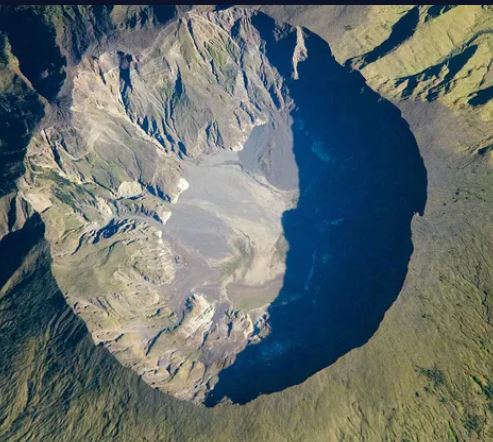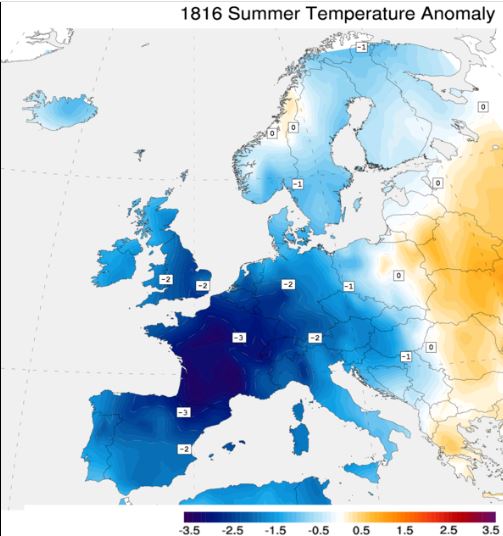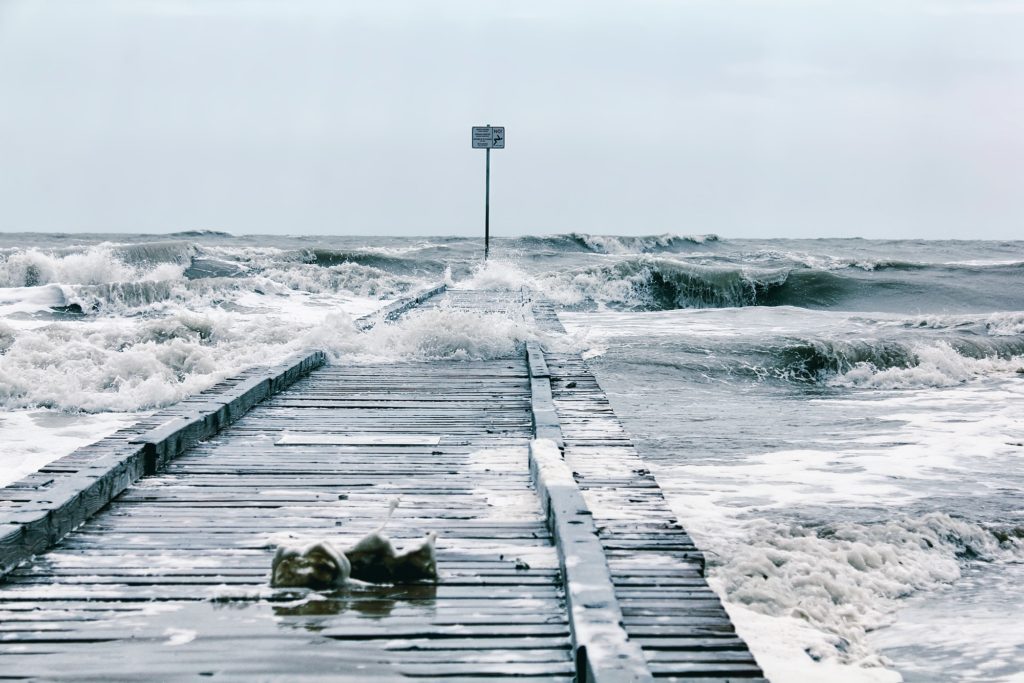With the first day of astronomical summer upon us, temperatures are rising and many of you are headed for the beaches. Back in the early 1800s farmers in the U.S. counted on warm temperatures and a stable growing season during the summer months. Most of these farmers lived east of the Appalachians.
All expectations went haywire in the summer of 1816. There was never any extended period of warmth and temperatures were even cold at times. Many deemed it “The Year Without A Summer”. The unusual chill extended to other areas of the globe, as well. The results were catastrophic and crop failures were extensive. Little did anyone know that the cause of these hardships came from an intense volcanic eruption on the other side of the globe which altered weather patterns worldwide !
Set Up For Disaster
We’ll begin by going back to the sprig of 1815 In the spring of 1815, when Indonesia’s Tambora volcano became much more active. On April 10th there was a massive eruption. The incredible roar of this explosion was heard over 1,000 miles away, and it created a tsunami that killed over 10,000 people around the Indian Ocean. Tambora spewed an overwhelming amount of volcanic ash, debris and gas skyward
Thirty eight cubic miles of volcanic ash were spewed into the atmosphere from Tambora, which is over 120 times the amount from the Mt. St. Helens eruption in Washington State back in 1980!
Indonesia’s Tambora volcano, as it appears today. (NASA)
The combination of volcanic ash and sulfuric acid, blocked incoming solar radiation, resulting in a much cooler planet. The sky was often tinted red for couple of years to come. There were no photographs in those days, but the reddish sky appeared in several artists paintings (see the example below).
Paintings by Caspar David Friedrich . Image Credit-Wikipedia-Public Domain.
The cold spells of 1816, lasting through the winter of 1817, were not confined to the U.S. It also turned very cold in western Europe and parts of Asia, leading to crop failures worldwide. Europe suffered from widespread food shortages, resulting in its worst famine of the century. The average global temperature was estimated to have dipped by over 1 degree F.
1816 summer temperature anomaly in Europe compared with average temperatures from 1971 to 2000.
NOAA is able to recreate jet stream patterns from the past, and although the pattern seen below was not in place for the entire summer of 1816, it is representative of a pattern that showed up frequently. A big dip in the jet stream (trough) allowed cold air to move into the Northeast quite frequently
 A recreated Jet Stream pattern over the U.S. with frequent deep troughs (dips) during the Summer of 1816. Graphic Credit (NOAA).
A recreated Jet Stream pattern over the U.S. with frequent deep troughs (dips) during the Summer of 1816. Graphic Credit (NOAA).
Prelude To Hardship
Following a mild winter, April arrived in the Northeast with plenty of showers with some warm spells, but there weren’t any hints of what was to come soon. Farmers planted their crops, the sheep were shorn and all seemed well.
Weather records indicate that the high temperature flirted with 80 degrees over southern New Hampshire on the last three days of the month.
Significant changes occurred in May, and that was not good news for plants, vegetables, livestock and even humans. According to weather records, a powerful cold front swept through New England on May 2. The temperature plunged to below freezing that night across much of interior New England.
A series of cold fronts, sweeping down from Canada, continued for the rest of the month. Throughout parts of Upstate New York and New England, the high temperature only made it to 70 degrees on a few occasions. There were many mornings with frost.
At times, ice was a half-inch thick on some rivers from northwest Pennsylvania through parts of upstate New York to New England, especially during the middle of the month. A few inches of snow also fell at that time, especially in higher elevations.
An Astonishing Summer
The onslaught of cold continued during the month of June. After a warm start, the temperature plunged rapidly on June 5 and snow began to fall. Much of southern New England and upstate New York had trace amounts, but higher elevations in interior sections of New England picked up 6 inches of snow.
Parts of Down East Maine recorded up to a foot of snow. Snow showers were reported on June 7 in Boston – their latest report of snow on record. The cold extended all the way down through the Middle-Atlantic States.
High temperatures didn’t escape the 20s in the higher terrain, all capped in snow.
Cape May, New Jersey, recorded five consecutive mornings with frost during the middle of June. Frost also occurred down to Maryland and Virginia. After a brief warm spell, temperatures plunged again around the end of the month.
July had more variations, but temperatures were generally below average for most of the month. It was particularly cold from the 4th to the 8th, and on the 4th, cold reached all the way down to the South. On that day, the temperature dipped into the upper 40s in Savannah, Georgia. On July 8, widespread frost was reported from Maine to Virginia. Albany, New York, reported several days with a hard frost.
The cold air coming down from Canada was also dry. Despite the bit of snow, there was very little rain after April, and the Northeast region was in a significant drought by July, just to add to the misery.
August was a warmer month and many farmers in the Northeast, trying to salvage what they could from the season, attempted to plant some crops. All hopes were dashed by the 20th, however, when another cold front swept through, followed by a killing frost.
Temperatures remained chilly for the rest of the month and the following fall and winter seasons were particularly cold. The overall impacts from the anomalous summer were far reaching ! Keep in mind that back then the U.S. was an agrarian society and nearly 90 percent of the population were farmers !
Catastrophic Impacts
Frost and freezing temperatures decimated the fruit crop across the Northeast. Corn, which was a staple (for humans and animals) across the Northeast, was completely destroyed. Vegetables, such as beans, cucumbers, and tender vegetation, were mostly wiped out from New England down to New Jersey. Livestock, such as sheep, froze to death and others perished from starvation due to lack of feed. There was severe inflation at the market for everyday goods like potatoes and bread. Many farmers became sick and died from diseases or lack of food.
Farmers in southern New England referred to the year as “eighteen hundred and starved to death.” All the way down to Virginia, the impacts were felt. Former President Thomas Jefferson lost about two-thirds of his crops and went into debt.
New Beginnings
Although some future events would have occurred over time, the nation was about to expand, and this event probably accelerated the process. Many farmers in the Northeast, especially in New England, migrated westward. Some traveled west of the Appalachians and into the Midwest to establish new farms.
Construction of the Erie Canal began in 1817, and it was opened in 1825. The Canal allowed more goods to be easily transported from the river systems of the Northeast back through the Great Lakes.
Subsequent volcanic eruptions would influence weather patterns for various periods of time but one has the overwhelming impact that this one did.





